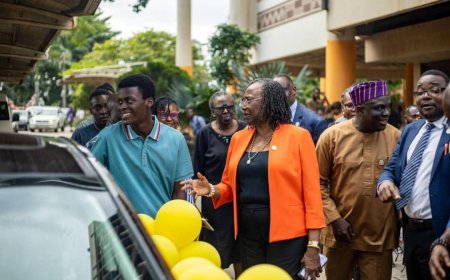Remembering Nigeria's Quintessential, Oldest and Longest Gospel Preacher, Pa Samuel Akinbode Sadela 10 Years After His Call to Glory
The Christian Church in Nigeria Lost One of Its Unforgettable Generals on Sunday Morning of August 24, 2014 at Exactly 4.30 am, When Revd. Samuel Akinbode Sadela Took His Bath, Dressed Up and Laid His Head on One of His Church Leaders, Saying He Wanted to Rest, Only to Breathe His Last. It's Exactly Ten Years Today Since His Call To Glory, Hence OTN News Remembers His Contributions to Christian Faith Via Publication of This Piece Culled From the Dictionary of African Christian Biography.

By: Michael Adeleke Ogunewu
*Introduction*
Rev. Samuel Akinbode Sadela was a remarkable man of God who was instrumental to almost all the Christian revivals witnessed in Nigeria. Born in 1900, he was reputed to be the oldest gospel preacher in the world, and Nigeria’s oldest living person upon his death at the age of 114, out of which he had put an amazing 82 years into the preaching of the gospel of Jesus Christ. He was the founder of the Gospel Apostolic Church. Sadela’s life was that of a man who rose from the position of a houseboy and tax collector to become one of the greatest preachers of the gospel in Nigeria.[1]
*Birth and Early Life*
Samuel Akinbode Sadela was born on the last Saturday of August, 1900 at Ifon, in the present Ondo State, South-West, Nigeria. His parents were Chief Olomonehin Sadela and Princess Adetiye Sadela. His father descended from the Olisa Chieftaincy House of Imoru and was second-in-command to the Olumoru of Imoru, the traditional ruler of his community. His mother was a princess of the Adanike-Amougba ruling house in Ifon. His grand-father Adidi was a traditional warrior of repute. Samuel however, grew up to become a warrior of Christ Jesus. It was not difficult for Sadela’s year of birth to be remembered, because it was the year the District Officer (a white man) under the colonial rule assumed duty at Ifon. Consequently, he was fondly referred to in the Yoruba language as “A ba Oyinbo de” or simply “Aboyinbode” by his parents, relatives and friends from childhood to adulthood. Aboyinbode means someone born around the time the white man arrived within the community.
It is told that in 1902 Akinbode, a toddler, was taught how to read the Holy Bible by the angels of God, who also gave him a “fruit of the tree of life” to swallow, which he did. At that time, he was unable to read any book other than the Bible.
*Education*
As the last child of a family of twelve, Samuel was highly pampered by his parents, who were not willing to send him to school. However, Samuel desired an education and his wish was fulfilled. He began his primary education at St. Paul’s Anglican Primary School Ifon, but his education was interrupted as a result of certain factors. He migrated to Sapele in the present Delta state where he spent years working as domestic help for expatriate colonial administrators. He served as a houseboy to Captain Pullen, the British District Officer. He also served Captains Balmour and Gavin as house help. [1a]
In 1918, he returned home and finally completed his primary education in 1920. He was an active member of the Boy Scouts. He narrowly missed an opportunity to travel to England in 1925 as part of the Nigerian Contingent of the Boy Scouts. He could not make the trip because his father was indisposed.[2] Many years later in 1946, he passed the Senior Cambridge examination, and later the London University Matriculation in 1949. He studied Law by correspondence with University College London and was scheduled to travel to London for a nine-month law course preparatory to being called to the Bar before his educational pursuit was, ironically, obstructed by the call of God. A renowned cleric of the time, Apostle Joseph Ayodele Babalola, advised him against going to London, as it was predicted that he would become a major voice in preaching the gospel. This was not the first prophecy given to him with regards to his call to the ministry. While working as a tax collector and court clerk, Sadela had met Moses Orimolade Tunolase, founder of the Cherubim and Seraphim Church, who also told him that his place was at the pulpit and not at the Bar.
*Marital Life*
Seun Akioye, in his article “Inside Sadela’s Gospel Apostolic Church,” gives insight into his aspect of Sadela’s life:
For a man committed to the work of God for so long, one would think he would be immune from the travails and problems of ordinary mortals. But Sadela has experienced one of the most bitter marriages ever known to man. At the age of 34 years, he got married to his first wife. The marriage lasted 21 unhappy years as the seven children from that marriage all died at infancy.
“When the seventh child was sick, I was crying to God for 22 days. Eventually, the child died and I wanted to know why not one of the children survived,” Sadela said during his 107th birthday anniversary.
He consulted with his mentor, Ayo Babalola and it was revealed through prayers that his wife was killing her own children through witchcraft. “She later ran away and confessed to the killing of her children through witchcraft, she died after the confession,” Sadela said. [3]
Africans in general and the Yoruba ethnic group of southwest Nigeria to which Sadela belonged in particular, live in a spiritual environment. A fall-out of this is the belief in the existence of malevolent spirits. Witches are a part of this belief. In the Yoruba worldview, they are malevolent spirits that delight in the perpetuation of evil either towards self or other. Awolalu explains that because witches are believed to maintain affinity with diabolical powers of the unseen world, they are seen as personifications of evil, as innately wicked people who work harm against others.[4] In the words of Idowu, “witches are human beings of very determined wills with diabolical bent… (they) are the veritably wicked ones who derives sadistic satisfaction from bringing misfortune upon other people.”[5] In the case of Sadela’s wife, it is believed that she was a witch who used her witchcraft to kill her seven children for certain diabolic satisfaction. In other words, she donated them to the spirit world to fulfill certain malicious objectives.
The following paraphrase of Akioye explains further:
For the next ten years, Sadela avoided women. He was too bruised and hurt to give marriage another trial. It had also raised questions about his genuineness as a man of God. Some people wondered how he had lived with a woman for twenty-one years and never discovered that she was a witch. However, his reaction was always to say, “My answer is very simple, no man is omniscient. God always reveals only what He wants to reveal to His servants, that is why He is God.” Sadela’s resolve to be celibate lasted until 1965 when he married Madam Juliana Ajisomo Sadela. The marriage produced four children of whom two survived – one boy and one girl. Both now play prominent roles in the church. However, their mother Juliana died in 2001 after a brief illness.
In 2007, Sadela married Christiana, a lady of 31 who had never been married before. This was an extraordinary event which drew criticism from some Christian leaders. Sadela would have none of it, claiming that it was a direct order from God. “After a brief search, he met the description revealed by God. The dowry was paid and following the directives of the Holy Spirit, the joining was done like the marriage in the Garden of Eden.” Sadela believed it was a re-enactment of the Biblical days: “If Seth the son of Adam married at the age of 105 and in this our own time a marriage is consummated between a 107-year-old man and a young woman of 31 years, then the Bible days are indeed here again,” he said. [5a]
*Church Ministry*
According to Akioye:
Sadela’s first encounter with God was in 1928 when he was a tax collector. It was a time of great revival in Nigeria led by men of God like Moses Orimolade, the founder of Cherubim and Seraphim Church. It was also the time of the great evangelist Apostle Ayodele Babalola who had a reputation for the performance of astounding miracles. Sadela, like Matthew the tax collector, met Moses Orimolade in 1928; Moses prayed for him and predicted he would become a great man of God. [5b]
He started his career with The Apostolic Church (TAC), but later pitched his tent with the Christ Apostolic Church (CAC). In 1931, he met Babalola at Oke-Oye, Ilesa. Babalola later became his leader and mentor. With him he commenced the ecclesiastical journey, and together they travelled to most parts of western Nigeria on crusade. As a close associate of Babalola, Sadela lived with him and shared his travails and his joys. They also fasted together for forty days and nights.
From 1932 to 1937, he served faithfully as a part-time pastor with the Christ Apostolic Church and helped to plant many branches of the church, especially in the Ikale-land of Ondo State, Nigeria. Specifically, he started the Okitipupa branch of the CAC in 1935. In 1937, he was ordained as a full-time pastor.
Sadela was passionate about the ministry committed into his hands. In 1944, during the Second World War, he went on a missionary journey, trekking from Odo-Owa to Ilorin - a distance of 112 miles (180 km). He undertook this journey with Elder Balogun, a leader of his church and a man named Victor, a member of the church. He was also reputed to have travelled the length and breadth of South-West Nigeria by bicycle for missionary journeys.
In December 1954, he invited Rev. Harold Curtis of Foursquare Gospel Church in the United States of America to Nigeria. This singular act was largely responsible for the establishment of Foursquare Gospel Church in Nigeria.
*The Gospel Apostolic Church*
According to the Guardian: “In 1959, just two weeks before his death, Apostle Joseph Babalola instructed Rev. Sadela to establish a church with the word “Apostolic” in the middle of its name. Consequent upon this instruction, Sadela eventually established his own church – the Gospel Apostolic Church (GAC), which he pastored for decades."[6] The church now has several branches in Nigeria and some overseas countries.
Certain observers within the gospel circle are of the view that just as Elisha was conferred with the double portion of Elijah’s anointing, Sadela inherited the Spiritual mantle of Ayodele Babalola. His church, the Gospel Apostolic Church (GAC), was fashioned after the doctrines prevailing in the Christ Apostolic Church. Also like Babalola his mentor, he was a conservative who frowned at excessive emphasis on wealth and materialism at the expense of the gospel.
He was a very devoted minister of the gospel who had a passion for the word of God and soul winning. Evangelism was a task very dear to his heart. An ethically sound minister, he forbade the use of church funds for personal purposes. As a result, all the things he owned were gifts from people who believed they had been blessed by his various ministrations. Rather than covet the wealth of the church, he used his personal funds to develop other upcoming men of God whom he considered to have performed creditably in their soul winning assignments. He built houses and bought cars for them to encourage their ministerial assignments.[7] In spite of the threat of prosperity theology which pervades modern-day Pentecostalism, Sadela’s message did not change throughout the entire eight decades of his ministry. It remained: “Repent for the Kingdom of God is at hand.” This is also evident in the simple lifestyle he adopted throughout his lifetime.
Sadela’s ministry was attended with signs and wonders. A few of these will suffice as examples. Sadela is credited with healing Jegede, a twenty-five year old man with mental afflictions, in 1947; in 1948 the corpse of a young man was miraculously brought back to life at a revival meeting in Akure.[8] In 1949, a woman suffering from an issue of blood for nine years was healed at Akure; another woman who was under the spell of a nine-year pregnancy which defied medical solution was delivered of a baby and both mother and child survived. In 1946, lepers were healed including a man at Idogun, Ondo State. Rev. Curtis of Foursquare Gospel Church was healed of a dangerous boil inside his ear in 1956, after he was anointed and prayed for by Rev. Sadela and several epileptics were healed including a man who was healed on Oloruntoyin Street Bariga, Lagos in 1977. In 1992 Sadela prayed for a woman who had been barren for 10 years and whose husband was said to have a low sperm count. She became pregnant and was delivered of the baby exactly on the day predicted by Sadela.
During his lifetime, Sadela was the grand patron of both the Christian Association of Nigeria (CAN) Lagos State Chapter and the Christian Pentecostal Fellowship of Nigeria (CPFN) Lagos State.
According to the Guardian, "Sadela’s longevity was always an interesting subject of discussion, especially because he combined it with unusually robust health." One usually expects that a man who gets to Sadela’s great age would have grown weaker with the passing years. However, the reverse was the case. "Even in old age, Sadela was strong and agile, with a healthy body, good dentition, sharp memory and good eyesight."[9a] He resided in a storey building where he descended the stairs once daily to carry out his daily routine. He was renowned for his energy and even athleticism on the pulpit as he preached. He never let any opportunity pass to advertise in words and actions his physical strength even when he was more than a century old.[9] He was married three times, each one after the demise of his former wife. When he marked his 113th birthday in 2014, Pa Sadela said:
I feel happy to be this old. Actually, I feel like a young man. I still enjoy my meal of Iyan (pounded yam), Eba and bush meat. I sleep whenever I want to and wake up stronger. I want to live longer to prove to all that God remains the same as He was in times past. If Methuselah could live for 969 years, God can make me live well beyond 113. If Noah could be 950, it is not too much for Him to make me live up to 200.[10]
However, Sadela eventually departed this world on Sunday morning of August 24, 2014 at the advanced age of 114. The incident that led to his death was not slow in coming. He had taken ill and had gone for his medical check-up at the Sacred Heart Hospital, Lantoro Abeokuta. On Sunday morning, at 4:30 am, he had taken his bath and got dressed. He then said he wanted to rest. He laid his head on one of the church leaders and passed on.
In a tribute the editor of the Guardian newspaper, Nigeria, described him as the evangelists’ evangelist and the one preacher who saw it all and preached it all; churches rose and churches fell, priests came and left, but Sadela was constant in the firmament, articulate, energetic and tireless in preaching the gospel.
His voice on the pulpit was no less sonorous in old age than it was in the early days. He was something of a “lonely voice” in Nigeria’s increasingly glamorous Christendom. Disinterested in priestly accoutrements or empire building, yet ministering to the flock from a single church, Sadela’s attitude was markedly different from the attention-seeking and wealth-flaunting phenomenon that has enveloped Nigerian churches in recent times. His was a voice that all respected and his was a life that beckoned to all to follow his example. [11]
He was a good and kind-hearted man, who did great good in his lifetime.
*Footnotes*
Seun Akioye, “Inside Sadela’s Gospel Apostolic Church,” The Nation (Nigeria), September 3, 2014, accessed October 8, 2014, http://thenationonlineng.net/new/inside-sadelas-gospel-apostolic-church/.
1a. Ibid.
Admin, “Life History of Rev. Samuel Akinbode Sadela (1900 – 2014),” *Eleven32 Equipping for Exploits *(blog), August 27, 2014, accessed April 17, 2016, http://www.eleven32.org/blog/?p=334.
Akioye, “Inside Sadela’s Gospel Apostolic Church.”
J. Omosade Awolalu, Yoruba Beliefs and Sacrificial Rites, (Essex: Longman Group Ltd., 1981), 80.
E. B. Idowu, “The Challenge of Witchcraft”, Orita: Ibadan Journal of Religious Studies 1, IV, (June 1970): 9.
5a. Akioye, “Inside Sadela’s Gospel Apostolic Church.”
5b. Ibid.
Editor, “Samuel Akinbode Sadela (1900 – 2014),” The Guardian (Nigeria), September 7, 2014, accessed October 8, 2014, http://www.ngrguardiannews.com/opinion/editorial/177992-samuel-akinbode-sadela-1900-2014. Currently available at http://archive.is/iWsde.
Bose Adelaja, “Independence Shocker”: World oldest preacher says Nigeria may split by 2015 except…,” *Vanguard *(Nigeria), October 2, 2011, accessed November 11, 2014, http://www.vanguardngr.com/2011/10/independence-shockerworld-oldest-preacher-says-nigeria-may-split-by-2015-except/.
This miracle was attested to by an expatriate medical officer in the Colonial Office who used his stethoscope to check and confirmed that the body was lifeless when the parents brought it to the revival ground.
Editor, “Samuel Akinbode Sadela (1900-2014),” The Guardian (Nigeria).
9a. Ibid.
Adenike Orenuga, “Nigeria’s oldest preacher dies at 114,”* Daily Post* (Nigeria), August 27, 2014, accessed April 17, 2016 http://dailypost.ng/2014/08/27/nigerias-oldest-preacher-dies-114/.
Editor, “Samuel Akinbode Sadela (1900-2014),” The Guardian (Nigeria).
This was researched and written by Dr. Michael Leke Ogunewu under the supervision of Rev. Dr. Deji Ayegboyin, DACB liaison coordinator.
Culled From Dictionary of African Christian Biography (DACB)
What's Your Reaction?























































